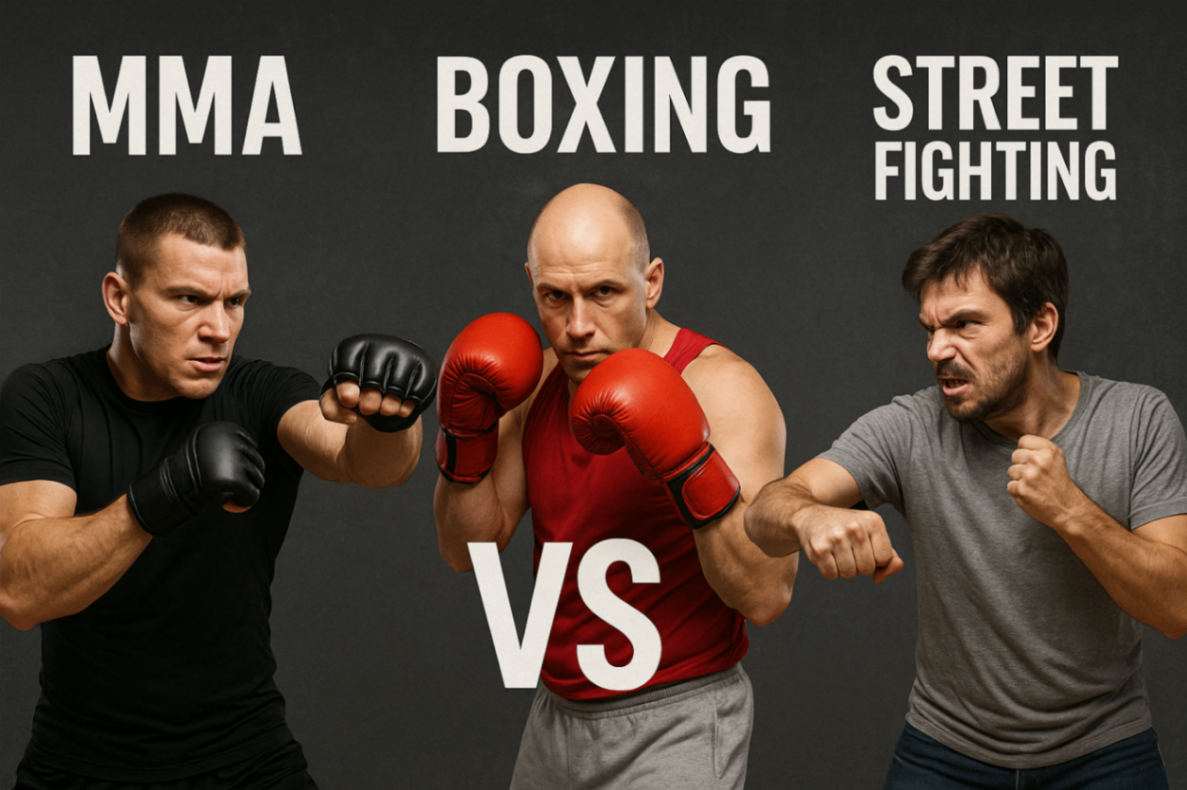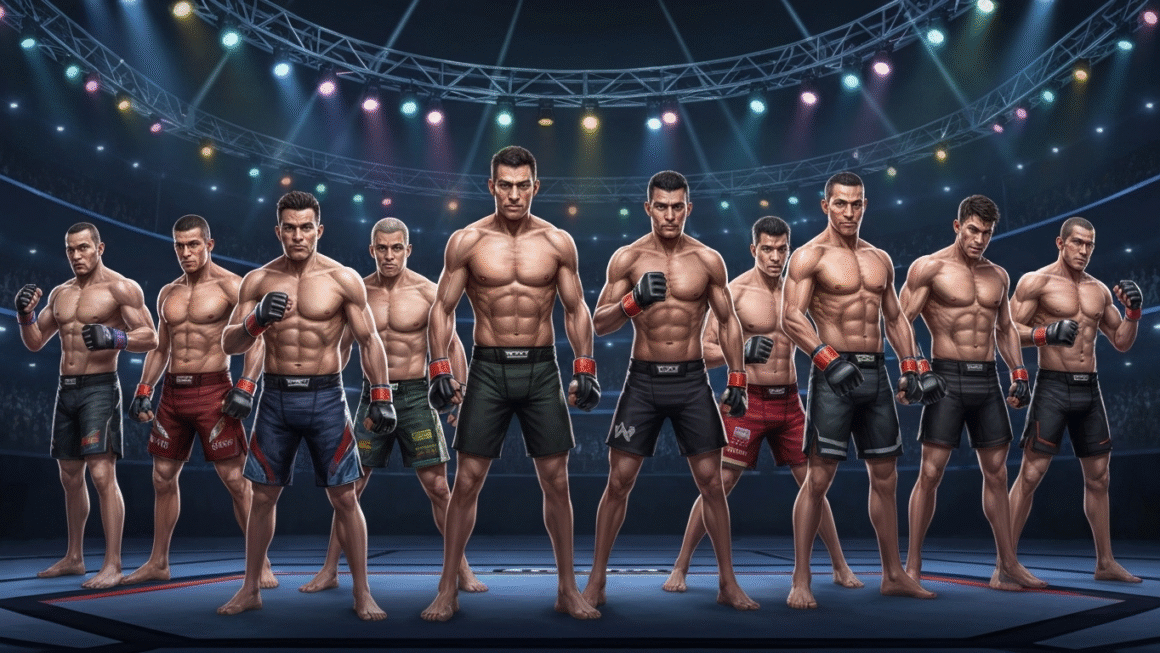Key Highlights
- Mixed Martial Arts (MMA) is a comprehensive martial art, blending striking and grappling for versatile self-defense.
- Boxing offers powerful striking and excellent footwork, which are effective techniques for stand-up confrontations.
- Street fighting is not a trained style but a chaotic, rule-free encounter focused on survival.
- The most effective approach for real-world self-defense often involves a combination of different skills.
- Training for a sport like MMA or boxing provides a disciplined framework that is more reliable than raw brawling.
- When choosing a martial arts gym for practical self-defense, look for one that offers programs emphasizing realistic scenarios, practical technique application, and a blend of stand-up and ground defense. A good gym should offer instruction in effective striking styles like boxing, as well as guidance on how to handle unpredictable street fighting situations.
- The most effective approach for real-world self-defense often involves a combination of different skills.
- Training for a sport like MMA or boxing provides a disciplined framework that is more reliable than raw brawling.
- Understanding the strengths and weaknesses of each discipline helps you choose the best path for your safety.
Introduction
When your personal safety is on the line, which fighting style comes out on top? The debate between different forms of the best martial art for self-defense is a long-standing one. Originally created for combat, these disciplines have evolved, with many now practiced as sports. However, the core question remains: what truly works in a real-world street fighting scenario? This guide compares MMA, boxing, and the harsh reality of street fighting to help you understand which is best suited for practical self-defense.
Comparing MMA, Boxing, and Street Fighting for Self-Defense
When considering an effective martial art for protection, MMA, boxing, and street fighting represent three distinct approaches. MMA is a hybrid system combining various martial arts techniques, boxing is a specialized striking art, and street fighting is an unpredictable, no-holds-barred brawl. How does the well-rounded nature of MMA compare to the focused power of boxing in an actual street fight?
Experts often recommend styles that cover multiple scenarios. While a boxer is formidable on their feet, an MMA practitioner is prepared for both standing and ground-based altercations. This versatility is a key factor when evaluating what will keep you safe in a chaotic encounter. Let’s examine the principles and training methods of each to see how they stack up.
Key Principles and Philosophies of Each Style
The philosophy of mixed martial arts is rooted in practicality and effectiveness. It incorporates techniques from different martial arts, such as wrestling, BJJ, SAMBO, and Muay Thai, to create a complete fighting system. This approach, similar to Bruce Lee’s philosophy for Jeet Kune Do, focuses on using “no way as way,” adapting to any situation by having a tool for every range of combat. The goal is to be prepared for anything an opponent might do.
In contrast, boxing follows the simple but profound principle of “hit and don’t get hit.” This philosophy emphasizes powerful, precise punches combined with evasive footwork and head movement. A boxer’s training is dedicated to mastering this narrow but highly effective skill set. Street fighting, however, has no philosophy; it is pure survival. Its only principle is to end the threat by any means necessary, making it dangerously unpredictable. The main factor that makes a martial art effective in a street fight is its adaptability to this chaos.
|
Style |
Core Principle |
Focus |
|---|---|---|
|
MMA |
Adaptability and versatility |
Blending striking, wrestling, and grappling |
|
Boxing |
“Hit and don’t get hit” |
Punching, footwork, and head movement |
|
Street Fighting |
Survival at all costs |
No rules, unpredictable attacks |
How Training Differs: Sport vs. Real-World Encounters
Is training for sport fighting, like UFC style, enough to handle real street encounters? The answer is complex. MMA training and other combat sports operate within a structured environment. This martial arts training involves rules, weight classes, referees, and protective gear. You learn techniques in a controlled setting, which builds muscle memory, conditioning, and discipline—all crucial assets.
However, real-world self-defense situations are completely different. There are no rules, no mats, and your attacker won’t respect a tap-out. A street fight can involve multiple opponents, hidden weapons, and hard concrete surfaces. The attacker’s goal isn’t to score points but to cause harm.
While sport training provides an excellent foundation, you must mentally bridge the gap. Your training gives you the tools, but you have to understand how to apply them in a chaotic, unregulated environment where your safety is the only objective. The conditioning and pressure-testing from sport are invaluable, but awareness of the differences is key.
MMA as a Self-Defense System
Mixed Martial Arts stands out as a superior system for self-defense because it is, by definition, a combination of the most effective disciplines, and it is known as the third most effective martial art. An MMA fighter is trained in striking, wrestling, and submission grappling, making them prepared for a fight wherever it goes. Can combining different martial arts improve your chances in a street fight? Absolutely, as it eliminates glaring weaknesses in your skill set.
Many real-world altercations end up on the ground. This is where MMA’s inclusion of ground fighting and grappling techniques becomes critical. Unlike a pure striker, an MMA practitioner knows how to handle being taken down, how to control an opponent on the ground, and how to get back to their feet. This adaptability makes MMA a practical choice for unpredictable situations.
Strengths and Weaknesses for Street Situations
The greatest strength of MMA in a street fight is its comprehensive nature. When you compare MMA to boxing, the difference is clear: MMA prepares you for all phases of a fight. You learn to strike, clinch, wrestle, and fight on the ground. This well-rounded skill set means you are less likely to be caught off guard by an attacker who tries to take you down.
This versatility provides a significant advantage. The effective techniques learned in MMA ensure you are prepared whether the fight stays standing or goes to the ground. Key strengths include:
- Adaptability: Ready for strikers, grapplers, or brawlers.
- Complete Skill Set: Combines striking, wrestling, and ground fighting with submissions.
- Realistic Training: Sparring in MMA simulates many aspects of a real fight.
However, MMA is not without its weaknesses. The intensity of the techniques can lead to injury, and using advanced grappling or submissions could cause serious, potentially life-altering harm to an assailant, which may lead to legal trouble. It requires immense dedication to become proficient in all areas.
Important Techniques Used in Real-Life Scenarios
In a real-life scenario, simplicity and effectiveness are paramount. MMA provides a host of self-defense moves, including elbow strikes, that are incredibly useful in street fights. Unlike flashy, complicated moves, these techniques are designed to neutralize a threat quickly and allow you to escape. Clinch work, for example, is vital for controlling an opponent in close quarters.
Once a fight goes to the ground, skills in grappling and submissions become your best defense. An untrained person is often helpless on their back, but an MMA practitioner can use ground fighting to control an attacker or apply a submission to end the confrontation without excessive striking. These moves are designed to be practical under pressure.
Some of the most useful techniques include:
- Clinch Control: Using clinch work to deliver knees and control the opponent’s posture.
- Takedowns: Taking the fight to the ground on your terms.
- Basic Submissions: Applying simple chokes or joint locks to neutralize an attacker.
- Low Kicks: Targeting an opponent’s legs to disrupt their balance and mobility.
Boxing for Real-World Self-Defense
Boxing is often called “the sweet science,” and for good reason. It is a highly effective striking art from Thailand for self-defense, focused on powerful punches, elusive head movement, and precise footwork. A trained boxer develops incredible power and the ability to avoid being hit, which are crucial skills in a standing confrontation.
However, how does it fare against the broader skill set of MMA? While a boxer has a distinct advantage on their feet against an untrained person, their lack of grappling defense is a significant vulnerability. The effectiveness of boxing in a street fight depends heavily on keeping the fight standing and ending it quickly with punches. We’ll explore its specific advantages and limitations next.
Advantages and Limitations in Street Fights
Boxing and kickboxing are effective martial arts for self-defense due to their focus on powerful, direct strikes. The training hones your reflexes, punching power, and defensive head movement, making you a formidable opponent in a stand-up exchange. A well-placed punch from a trained boxer can end a fight in seconds.
This specialization is both a strength and a weakness. While you shouldn’t necessarily avoid boxing for self-defense, you must be aware of its gaps. Its primary limitations are a complete lack of ground fighting and defense against common street attacks like takedowns or kicks. If an attacker manages to grab you and take you to the ground, a boxer is in unfamiliar and dangerous territory.
Here are the core advantages and limitations:
- Advantage: Exceptional punching power and speed.
- Advantage: Superior footwork and head movement for defense.
- Limitation: No defense against kicks or takedowns.
- Limitation: No ground fighting skills, a major vulnerability in many fights.

Effective Boxing Moves for Self-Defense
Boxing offers several highly effective moves for self-defense that are easy to apply under pressure. The most important of these is the jab. A sharp, quick jab can keep an attacker at a distance, disrupt their rhythm, and set up more powerful punches. It’s a versatile tool for both offense and defense.
Beyond punching, the defensive techniques of boxing are invaluable. Using footwork to create angles and maintain distance is a key survival skill. Slipping and rolling under punches allows you to avoid damage while staying in position to counter-attack. These skills help you follow the core boxing philosophy: hit and don’t get hit.
Here are some of the most useful boxing moves for a street fight:
- The Jab: Controls distance and disrupts the aggressor.
- The Cross: A powerful straight punch to end the confrontation.
- Evasive Footwork: Staying mobile to avoid being cornered or overwhelmed.
- Covering Up: Protecting your head from wild, incoming punches.
Street Fighting: Unregulated and Raw Techniques
Street fighting is not a discipline you can learn in a gym; it is a brutal reality. What makes it unique is its complete absence of rules. There are no referees, no weight classes, and no honor system. You may be facing multiple attackers, hidden weapons, or an aggressor who will use any means necessary to win.
The raw techniques used in street fighting include eye-gouging, biting, and strikes to the groin—moves that are illegal in any combat sport, such as karate. The primary factor that makes a martial art effective in this environment is its ability to prepare you for this chaos and help you neutralize a threat as quickly as possible so you can escape.
What Makes Street Fighting Unique?
The defining characteristic of street fighting is its unpredictability. Unlike a sanctioned match, a real-world fight has no structure. The aggressor won’t stand in a fighting stance; they may launch a surprise attack, pull a weapon, or have friends waiting to jump in. The environment itself is a weapon, with hard pavement, walls, and other obstacles.
Common street attacks are not clean techniques. They are wild haymakers, clumsy tackles, and desperate grabs. An attacker’s only goal is to incapacitate you. This raw, chaotic nature is what makes street fighting so dangerous. You are not fighting for points or a title; you are fighting for your safety.
Because of this, the most effective mindset is one of awareness and avoidance. The best street fight is the one that never happens. However, if forced to engage, your goal must be to end the confrontation immediately and create an opportunity to escape, not to “win” a prolonged battle.

Risks and Challenges of Relying on Street Fighting
Relying on raw instinct or a “street fighting” mentality for self-defense is incredibly risky. Without formal training, you lack the conditioning, technique, and composure needed to handle a determined assailant. You are betting that your aggression can overcome your opponent’s, which is a dangerous gamble.
This approach should be avoided if your goal is effective self-defense. Formal training in a martial art like MMA or boxing provides structure, discipline, and proven techniques. It prepares your body and mind for the stress of a physical confrontation. Relying on brawling instinct leaves you vulnerable and unprepared.
The primary risks and challenges include:
- High Risk of Injury: Untrained fighting often leads to serious injuries for both parties, such as broken hands or head trauma.
- Legal Consequences: Causing excessive harm can lead to assault charges.
- Lack of Conditioning: A real fight is exhausting; without proper conditioning, you will tire quickly.
- No Defensive Skills: You won’t know how to defend against a trained striker or grappler.
Conclusion
In conclusion, choosing the right fighting style for self-defense boils down to understanding the strengths and weaknesses of MMA, boxing, and street fighting. Each discipline offers unique techniques and philosophies that can be effective in different scenarios. While MMA provides a comprehensive approach to self-defense with its varied techniques, boxing emphasizes powerful strikes and footwork, and street fighting takes a more instinctual, unregulated route. By weighing these factors and aligning them with your personal safety needs, you can make an informed decision. Remember, honing your skills through dedicated training will ultimately prepare you better for real-world encounters. If you’re looking to enhance your self-defense abilities further, consider exploring new training options or classes to expand your skill set.
Frequently Asked Questions
Can mixing martial arts improve your self-defense ability?
Yes, mixing martial arts significantly improves your self-defense capabilities. MMA training combines striking and grappling techniques, eliminating weak spots in your skill set. This versatility ensures you are better prepared to handle the unpredictable nature of a real fight, whether it stays standing or goes to the ground.
Are there martial arts you should avoid for street self-defense?
While any martial arts training is better than none, styles that are heavily focused on sport fighting with restrictive rules, like some forms of Taekwondo, or those that lack pressure testing, such as Aikido, may be less practical for self-defense than more combat-oriented systems like MMA or Krav Maga.
How important is ground fighting in real street encounters?
Ground fighting is incredibly important, as many street fights end up on the ground. Skills from BJJ, wrestling, or MMA allow you to leverage control over an opponent, defend against attacks, or use submissions like chokes to neutralize a threat without excessive striking, providing a path to safety.
Sources:
- Bruce Lee Foundation. (n.d.). Jeet Kune Do. Retrieved from https://bruceleefoundation.org/jeetkunedo/
- Fong, D., & Mullan, M. (2014). The role of Taekwondo in the treatment of psychiatric disorders. Australasian Psychiatry, 22(1), 78–81. Retrieved from https://journals.sagepub.com/doi/abs/10.1177/1039856213509657
- Krav Maga Global. (n.d.). The Founder of Krav Maga. Retrieved from https://krav-maga.com/krav-maga-by-krav-maga-global/the-founder/




